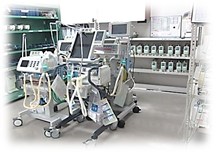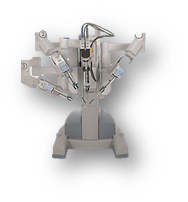Modern medicine relies on a wide variety of advanced medical machines and devices. We are the professionals specializing in medical machines and devices in Japan, called National Registered Clinical Engineers (CE). Clinical engineer is a unique medical profession having dual responsibilities for both clinical aspect and technologies, which will not probably be seen in other countries. It requires a national licensing. The licensing examination system was established in 1987 in Japan.
When the Shizuoka Cancer Center opened in 2002, one CE and 2 subcontracting staff were assigned to managing medical machines and equipment. Currently, ten CEs and 5 subcontracting staff are assigned to medical machine and equipment management office (as of 2024)

Officially it is the Medical Machine and Equipment Management Office.
We centrally control 8,797 units of medical machine and equipment (as of Dec 2024)) in the entire wards, including heart-lung machines, ventilators, surgical machines, hemodialysis machines, endoscopic machines, defibrillators, infusion and syringe pumps, etc. The medical machines and devices going out and coming back for circulation are from 250 to 300 units a day. We inspect each medical machine manually for all of the patient receiving treatments at the Shizuoka Cancer Center Hospital, so that the medical staff, the patients and their families can use them without any concerns. Additionally, we control the whole hospital equipment and office machinery, too, such as safety boxes for narcotics, copiers, shredders, wheel chairs, walkers, etc.
In summary, the staff at the Medical Machine and Equipment Management Office are just like the concierges inspecting and fixing all the machines in the Shizuoka Cancer Center Hospital.
We are responsible for selecting medical machines which meet the national standards regarding safety, reliability and usability. Additionally, we inspect the medical machines daily and routinely, because their malfunctions and troubles need to be minimized as much as possible. As a result of our job, their functionality and reliability are always maintained.
In 2014, 31,084 units of the medical machines were inspected and repaired, 36,968 units in 2015, 36,361 units in 2016, 32,291 units in 2017, 38,270 units in 2018, 46,031 units in 2019, and
41,157 units in 2020, 42,769 units in 2021, 42,758 units in 2022 and 45,583 units in 2023.
Because a ventilator is a life supporting machine, CEs have to patrol in the wards and check on ventilators regularly. Then, we keep records on the operating statuses based on our inspection table to maintain the safety. Furthermore, we adjust the parameters to maintain the synchronism of patient’s breathing and mechanical ventilation under the supervision of a physician.
Our clinical services covered 267 cases in 2014, 188 cases in 2015, 183 cases in 2016, 326 cases in 2017, 97 cases in 2018, 136 cases in 2019, 83 cases in 2020, 115 cases in 2021, 81 cases in 2022, and 136 cases in 2023
CEs are responsible for maintenance dialysis for perioperative patients. In addition, we provide hemodialysis (HD), hemofiltration (HF), and hemodiafiltration (HDF) for acute renal failure developed during chemotherapy. Furthermore, we are also responsible for various apheresis including plasma exchange (PE), cell free and concentrated ascites reinfusion therapy (CART), and immunoadsorption. We periodically inspect the machines used for these therapies and manage dialysate as part of our responsibilities.
CEs provide continuous renal replacement therapy (CRRT) around the clock (or longer) for patients with unstable physical conditions or patients with multiple organ dysfunctions due to severe and opportunistic infections. Additionally, we also provide on demand endotoxin adsorption therapy (polymyxin B hemoperfusion) for removing inflammatory toxins in the body.
Our clinical services covered 233 cases in 2011, 104 cases in 2012, 330 cases in 2013, 248 cases in 2014, 190 cases in 2015, 265 cases in 2016, 181 cases in 2017, 345 cases in 2018, 156 cases in 2019, 139 cases in 2020, 135 cases in 2021, 93 cases in 2022 and 142 cases in 2023.
CE’s clinical services for cardiac therapy are classified into the following three tasks. Our clinical services in this field covered 346 cases in 2014, 404 cases in 2015, 534 cases in 2016, 488 cases in 2017, 293 cases in 2018, 295 cases in 2019, 356 cases in 2020, 230 cases in 2021, 258 cases in 2022. and 275 cases in 2023.
・Operating supportive heart-lung machine
CEs are responsible for administering and operating intra-aortic balloon pumping machine (IABP) and extracorporeal membrane oxygenation (ECMO) in order to support patients with cardiac dysfunction.
・Operations at the catheterization laboratory
Firstly, CEs perform the direct assistance for physicians for their procedures including coronary angiography (CAG) and percutaneous coronary intervention (PCI) for treating unstable angina and acute myocardial infarction. Secondly, we run an electrocardiograph system in CAG and PCI, and keep records of the physiological data such as electrocardiogram waveforms. Finally, we prepare and operate IABP, ECMO, and an extracorporeal temporary pacemaker for bradycardia as well as devices for CAG and PCI.
・Management of cardiac implantable electronic devices (CIEDs)
CIEDs including heart pacemaker and implantable cardioverter-defibrillator are used for treating fatal arrhythmia. During the implantation surgery, CEs have to operate a device called a programmer to check and adjust the CIED, and we evaluate the performance of the CIED at the outpatient clinic after the patient is discharged from the ward. Additionally, we adjust the parameters of CIEDs for patients undergoing surgeries and radiotherapies, so that they won’t be affected by electrical noises produced from high-frequency electric devices such as surgical scalpels.
 The operation room has the most diverse types of medical machines in our hospital. There are 610 units of 120 types of machines and devices (as of March, 2019). The number of medical machines in the operation room has been increasing year by year in accordance with advances of medical technology (e.g. anesthesia apparatus, electric scalpel, surgical microscope, surgical image support device, ultrasonic device, robot-assisted surgery machine, etc.). Periodic inspections of these machines are needed definitely, because strict regulations are set upon them to ensure safe and smooth functions, which automatically contributes to safe surgeries. CEs conduct pre/post-surgery inspections, and always respond swiftly in case of machine troubles.
The operation room has the most diverse types of medical machines in our hospital. There are 610 units of 120 types of machines and devices (as of March, 2019). The number of medical machines in the operation room has been increasing year by year in accordance with advances of medical technology (e.g. anesthesia apparatus, electric scalpel, surgical microscope, surgical image support device, ultrasonic device, robot-assisted surgery machine, etc.). Periodic inspections of these machines are needed definitely, because strict regulations are set upon them to ensure safe and smooth functions, which automatically contributes to safe surgeries. CEs conduct pre/post-surgery inspections, and always respond swiftly in case of machine troubles.
Our technical services in the operation room covered 309 cases in 2014, 284 cases in 2015, 306 cases in 2016, 215 cases in 2017, 382 cases in 2018, 514 cases in 2019, and 581 cases in 2020. 643 cases in 2021, 767 cases in 2022.and 905 cases in 2023
 In recent years, endoscopic systems involving machines for endoscopic examination and treatment have become more and more complicated because of the combinations with many electronic devices and other medical devices (e.g., high-resolution monitor, CCD camera, electronic scope, suction device, large capacity image recorder, electric scalpel, high-frequency snare treatment device, etc.). CE has worked for the Division of Endoscopy since 2013, to ensure accurate, smooth and safe operation of endoscopic machines. The number of endoscopic examinations is about 16,000 and treatments are about 1,000 cases per year, respectively. Among them, the number of our direct clinical involvement was 1,962 cases in 2014, 2,771 in 2015, 2,810 in 2016, 1,905 in 2017, 1,347 in 2018, 802 cases in 2019, and 2,336 cases in 2020. 1,837 cases in 2021, and 3,053 cases in 2022 and 2,842 cases in 2023.
In recent years, endoscopic systems involving machines for endoscopic examination and treatment have become more and more complicated because of the combinations with many electronic devices and other medical devices (e.g., high-resolution monitor, CCD camera, electronic scope, suction device, large capacity image recorder, electric scalpel, high-frequency snare treatment device, etc.). CE has worked for the Division of Endoscopy since 2013, to ensure accurate, smooth and safe operation of endoscopic machines. The number of endoscopic examinations is about 16,000 and treatments are about 1,000 cases per year, respectively. Among them, the number of our direct clinical involvement was 1,962 cases in 2014, 2,771 in 2015, 2,810 in 2016, 1,905 in 2017, 1,347 in 2018, 802 cases in 2019, and 2,336 cases in 2020. 1,837 cases in 2021, and 3,053 cases in 2022 and 2,842 cases in 2023.
CEs inspect medical machines when they have troubles and analyze the causes. We share the analysis results with the relevant department which requested the survey. We make the information available for other departments, too, for future management in the hospital.
 CEs conduct the periodic safety training sessions on the variety of medical machines (e.g., surgical scalpels, hemodialysis machines, ventilators, oxygen therapy devices, defibrillators, infusion pumps, pacemakers, heart lung machines, endoscopic machines, etc.) for the medical professions who need to handle them. We held 66 sessions in 2014 (1,040 participants in total), 76 in 2015 (926), 78 in 2016 (971), 132 in 2017 (3,798), 139 in 2018 (4,904), 106 in 2019 (4137), and 81 in 2020 (3350). 117 in 2021 (3,130), 107 in 2022 (3,178) and 155 in 2023(2,842).
CEs conduct the periodic safety training sessions on the variety of medical machines (e.g., surgical scalpels, hemodialysis machines, ventilators, oxygen therapy devices, defibrillators, infusion pumps, pacemakers, heart lung machines, endoscopic machines, etc.) for the medical professions who need to handle them. We held 66 sessions in 2014 (1,040 participants in total), 76 in 2015 (926), 78 in 2016 (971), 132 in 2017 (3,798), 139 in 2018 (4,904), 106 in 2019 (4137), and 81 in 2020 (3350). 117 in 2021 (3,130), 107 in 2022 (3,178) and 155 in 2023(2,842).
 In Shizuoka prefecture, the “Pharma Valley Project” has been promoted for which the Shizuoka Cancer Center functions as a core facility. With the Project, we are developing products for the use by patients, their families and medical professions through collaborations with local companies having potential technologies. As one of the achievements, we developed the “identification labels” for medical devices in 2013 (see the photo above). This has made it easy to recognize visually whether the medical machines and equipment are having been used or not. Even when the surface of the label is processed as water repellent, you will still be able to write on it. When the label is peeled off, it won’t leave sticky marks on the machine and the removal will be quite smooth. This product was highly acclaimed at the Japanese Society of Medical Instrumentation when it was first introduced.
In Shizuoka prefecture, the “Pharma Valley Project” has been promoted for which the Shizuoka Cancer Center functions as a core facility. With the Project, we are developing products for the use by patients, their families and medical professions through collaborations with local companies having potential technologies. As one of the achievements, we developed the “identification labels” for medical devices in 2013 (see the photo above). This has made it easy to recognize visually whether the medical machines and equipment are having been used or not. Even when the surface of the label is processed as water repellent, you will still be able to write on it. When the label is peeled off, it won’t leave sticky marks on the machine and the removal will be quite smooth. This product was highly acclaimed at the Japanese Society of Medical Instrumentation when it was first introduced.
Prepared by Takamitsu Kubo, general manager of national registered clinical engineer,
December 2024.